Ancient and Medieval States
Background
Proto-Coinages
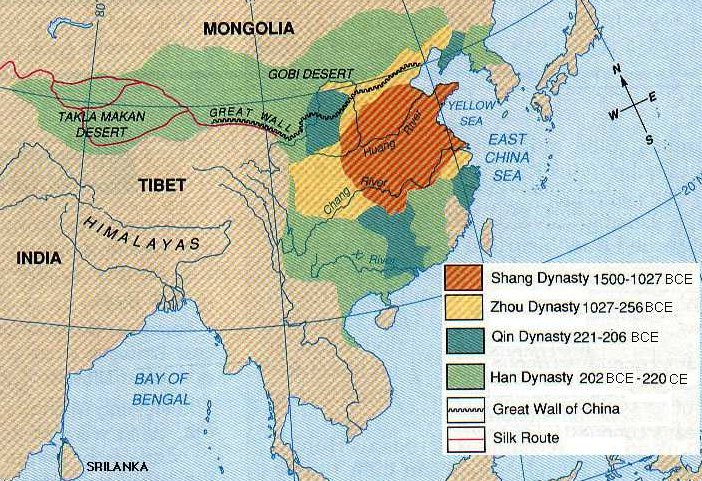
There is no sharp distinction between proto-coins and coins proper, but the latter are generally taken to have:
1. The mark of the issuing authority.
2. An intrinsic value bearing some relationship to the face or circulating value. The intrinsic value was generally less than the face value, but not so low as to make the piece into a token rather than a coin.
3. A denominational value that eliminates the need for weighing at every transaction.
Coinage proper was preceded by objects that resemble coins, and may indeed have served for debt and tax payments, or even trade, but about which we say little for certain. Proto-coins are known from China, India and Europe, and may date back to the second millennium BC, but are probably rather younger. Lumps, bars, rings, hooks, knives, axes and shovels are the common forms. 'Primitive' money was used in Africa and Oceania within living memory, but served ritual purposes, generally serving to tokenise and strengthen the social fabric, serving for blood money or bride purchase rather than trade in local markets. The same purpose probably applies to proto-coinages, though there are few written records or even folk legends to guide us. Some pieces, like the punch-marked pieces of the Mauryan empire very probably were used in markets — they are standardized in weight, silver purity and symbols used — but anything less convenient for trade than the utensil coinage of China would be hard to imagine. The pieces are cumbersome, pointed and fragile. Some may be individual creations like the famous Shang and Zhou bronzes, but the 'Ming knives' are particularly common and found over a wide area. That the pieces were in some way cherished we must suspect from their being found in hoards with round coins, but that inclusion may not amount to a measure or store of abstract value. Indeed the copper axe found with the 5,000-year old body of a man discovered on the Austrian-Italian border in 1991 may have been a token of status or occupation — he was probably a metal worker — as it was too soft to have had any practical use.
Cowries were used extensively in early China, and in Africa until recently. By the 1920s, thousands of tons had been imported from the Maldives Islands, Oceania, and the shorelines of Africa, the Middle and Far East. Their value decreased with supply, so that the two cowries needed at the end of the 18th century to purchase a women in central Africa had swelled to one thousand by 1860. {1}
Cappadocia around 2250-2150 BC employed silver ingots, state-authenticated in weight and purity, and these in time grew smaller, before dwindling into rods, spits and elongated nails. {13} Cattle and slaves were status objects in the ancient world, however, and that standard gradually, around 1500 BC to 1000 BC in Mediterranean countries, gave way to a gold or gold-silver by weight. The earliest Greek coins were stored in temples, which served both as centres for business and religious ceremony. The silver pieces did circulate as coinage, but the gold tended to be kept in temple treasuries. Silver was also used as a measure of value in Mesopotamia, but not circulated as coins. Otherwise, it was copper or bronze that generally served for proto-coinage, at least until iron could be smelted and worked, when iron objects also appear, as in Sparta. The glass and porcelain scarabs found in Egyptian tombs may also have served as coins, some archaeologists believe, but again this is only conjecture. Even Greek literature is silent on the introduction of coinage, though it was widely used in classical times. In short, we don't know, and it's entirely possible that coinage and proto-coinage arose at different times in different places to serve different but overlapping purposes. {2}
China
The traditional classification was knife, spade, cowry imitation, and early round coins, which were all assigned to the 1046-256 BC Zhou Dynasty, though the last phase is commonly called the Period of the Warring States. {3} Much  remains unclear about these proto-coinages. {4} Earlier writers put their use back in the early Zhou, but most authorities now believe a 6th or 7th century BC origin is more likely, though cowry shells could have been used in the preceding Shang Dynasty. The bronze pieces employ an antique calligraphy, in forms long out of fashion by the time of casting, and the characters are sometimes difficult to read: indeed the inscriptions are generally held to be unreliable for identification purposes. A standard by weight (zhu) seems to apply, though the casting process creates individual variations. The official weight of a zhu was 0.65 grams, with 24 zhu to a liang of 15.6 grams. Spade pieces were denominated in multiples of 6 zhu with issues 72 zhu or 3 liang (36 grams), 48 zhu or 2 liang (24 grams), 24 zhu or 1 liang (12 grams) and 12 zhu or 1/2 liang (6 grams). Knife pieces were denominated in a system based on multiples of 10 zhu although the main denomination for thin knifes was 30 zhu (about 15 grams). Early round coins seem to follow the knife money system based on multiples of 10 zhu, with most issued at 20 zhu (10 grams). Cowry imitation (including ant-nose coins) pieces do not seem to follow any weight standard, however (nor, of course, did the actual cowry shells, which were simply counted). Spades are often denominated in zhu or liang, but knife pieces are not. Proto-coinage and round coins 'circulated' contemporaneously, and proto-coinage was not abandoned until Han times. {5} The wide variety in spade and knife pieces reduces around the mid 4th century to minor variations of the thin 1/2 and 1 Jin flat foot spades, and 'Ming' knife forms. Round coins also appear, and both developments probably point to more extensive trade between the warring states. {4-6}
remains unclear about these proto-coinages. {4} Earlier writers put their use back in the early Zhou, but most authorities now believe a 6th or 7th century BC origin is more likely, though cowry shells could have been used in the preceding Shang Dynasty. The bronze pieces employ an antique calligraphy, in forms long out of fashion by the time of casting, and the characters are sometimes difficult to read: indeed the inscriptions are generally held to be unreliable for identification purposes. A standard by weight (zhu) seems to apply, though the casting process creates individual variations. The official weight of a zhu was 0.65 grams, with 24 zhu to a liang of 15.6 grams. Spade pieces were denominated in multiples of 6 zhu with issues 72 zhu or 3 liang (36 grams), 48 zhu or 2 liang (24 grams), 24 zhu or 1 liang (12 grams) and 12 zhu or 1/2 liang (6 grams). Knife pieces were denominated in a system based on multiples of 10 zhu although the main denomination for thin knifes was 30 zhu (about 15 grams). Early round coins seem to follow the knife money system based on multiples of 10 zhu, with most issued at 20 zhu (10 grams). Cowry imitation (including ant-nose coins) pieces do not seem to follow any weight standard, however (nor, of course, did the actual cowry shells, which were simply counted). Spades are often denominated in zhu or liang, but knife pieces are not. Proto-coinage and round coins 'circulated' contemporaneously, and proto-coinage was not abandoned until Han times. {5} The wide variety in spade and knife pieces reduces around the mid 4th century to minor variations of the thin 1/2 and 1 Jin flat foot spades, and 'Ming' knife forms. Round coins also appear, and both developments probably point to more extensive trade between the warring states. {4-6}
Ancient India: c. 600-470 BC
In what may be an independent development, unrelated to events in Lydia or China, the first Indian coins appear with the 6th century BC Mahajanapadas of the Indo-Gangetic plain: punch-marked pieces of irregular shape but constant weight. There were sixteen kingdoms and oligarchic republics, and some issues can be identified by their symbols. Saurashtra used a humped bull, Dakshin Panchala a Swastika, while others, like Magadha, used several symbols.
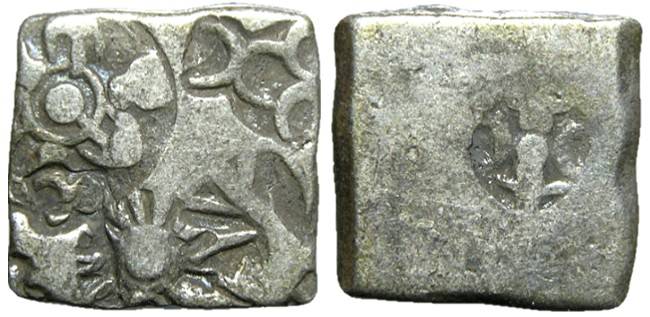 The 322-185 BC Mauryan Empire extended the issues. Each coin (karshapana) weighed 32 rattis and contained 50-54 grains of silver. Some 450 different punch-marks are known, the most common being the sun and six-armed symbols, various geometrical patterns, circles, wheels, human figures, animals, bows and arrows, hills and trees etc. A few coins are inscribed with Brahmi legends in Prakrit. {7-9}
The 322-185 BC Mauryan Empire extended the issues. Each coin (karshapana) weighed 32 rattis and contained 50-54 grains of silver. Some 450 different punch-marks are known, the most common being the sun and six-armed symbols, various geometrical patterns, circles, wheels, human figures, animals, bows and arrows, hills and trees etc. A few coins are inscribed with Brahmi legends in Prakrit. {7-9}
Iron Age Europe
A wide variety of objects found in archaeological sites — rings, miniature axes, bells, bars of metal — can be 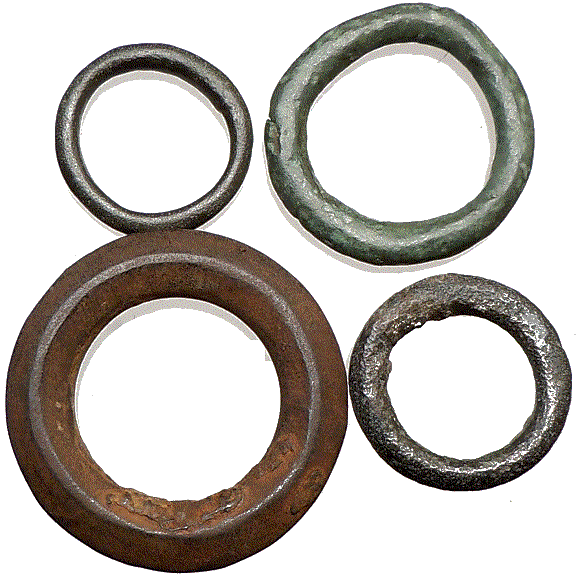 ascribed to Europe's proto-coinages, though the uses are unclear, as is much about a period for which there are few written records. Commonly the metal of these proto-coinages is bronze, which in the later Celtic issues was mixed with tin to give the low-value potin coinages. The Spartans used bundles of metal rods, and iron rings are also found in northern Europe. Julius Caesar noted the British Celts employed crude iron blades for currency, in conjunction with their precious metal coins. {1}
ascribed to Europe's proto-coinages, though the uses are unclear, as is much about a period for which there are few written records. Commonly the metal of these proto-coinages is bronze, which in the later Celtic issues was mixed with tin to give the low-value potin coinages. The Spartans used bundles of metal rods, and iron rings are also found in northern Europe. Julius Caesar noted the British Celts employed crude iron blades for currency, in conjunction with their precious metal coins. {1}
Proto-coinages are sometimes found in large numbers in burial sites, suggesting a religious significance, though it's possible the items were also used for day-to-day purchases.
In Celtic coins proper, gold issues are far more common than silver, probably because, though less available, the metal was more easily extracted. Some hundred odd metal mines are known from the period in England and France. {10}
Lydia
Coins proper appeared first in Lydia (southern Turkey), shortly followed by the neighbouring Ionia (south-west Turkey). The hoards uncovered beneath the temple of Artemis built around 600 BC at Ephesus suggest that true coins date from around 640-630 BC (in Lydia, where examples show early stages of coin development whereas other areas do not). The first coins were little more than 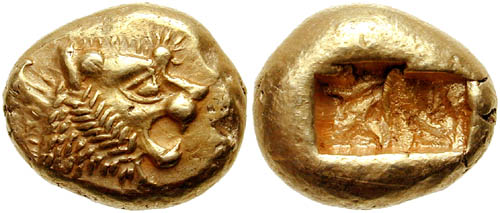 lumps of the electrum obtained by panning the local rivers, but by mid 6th century BC, the Lydians had managed to separate the gold from silver, and Croesus issued a bi-metallic coinage. Thereafter, the practice of coinage spread - eastwards when Lydia was absorbed into the Persian Empire in 546 BC, and westwards to Ionia, the Aegean islands, mainland Greece, the Greek settlements (especially Sicily) and thence to Macedonia, Thrace and the Black Sea. Coins probably appear in Aegina around 595 BC, in Athens around 575 BC and in Corinth around 570 BC. Trade and taxes were the uses served. {1} Merchants were obliged to exchange their bullion for coins of equivalent face value, a fiduciary money whose value was set by fiat of the state. Generally the coins — small, very crudely made ovals of electrum — held less silver and gold at prevailing market values than the bullion for which they were exchanged, that difference going to the state, which grew very wealthy. Taxes had also to be paid in coinage, which was used to maintain the administration and the army — a sort of protection money racket that created a trading enclave beyond the reach of Persia, believes Graeber {12}. Countries were thereby shielded from big power exploitation, avoiding debt peonage and allowing independent yeomen to bring up sons to serve in the army, where they made better soldiers than conscripted men. Spheres of coinage use became self-contained, internally integrated economies of common purpose. {2, 11-12}
lumps of the electrum obtained by panning the local rivers, but by mid 6th century BC, the Lydians had managed to separate the gold from silver, and Croesus issued a bi-metallic coinage. Thereafter, the practice of coinage spread - eastwards when Lydia was absorbed into the Persian Empire in 546 BC, and westwards to Ionia, the Aegean islands, mainland Greece, the Greek settlements (especially Sicily) and thence to Macedonia, Thrace and the Black Sea. Coins probably appear in Aegina around 595 BC, in Athens around 575 BC and in Corinth around 570 BC. Trade and taxes were the uses served. {1} Merchants were obliged to exchange their bullion for coins of equivalent face value, a fiduciary money whose value was set by fiat of the state. Generally the coins — small, very crudely made ovals of electrum — held less silver and gold at prevailing market values than the bullion for which they were exchanged, that difference going to the state, which grew very wealthy. Taxes had also to be paid in coinage, which was used to maintain the administration and the army — a sort of protection money racket that created a trading enclave beyond the reach of Persia, believes Graeber {12}. Countries were thereby shielded from big power exploitation, avoiding debt peonage and allowing independent yeomen to bring up sons to serve in the army, where they made better soldiers than conscripted men. Spheres of coinage use became self-contained, internally integrated economies of common purpose. {2, 11-12}
Early Rome: From State to Empire
Matters were more complex in Italy. Gold was readily available but the Roman state first used crude lumps 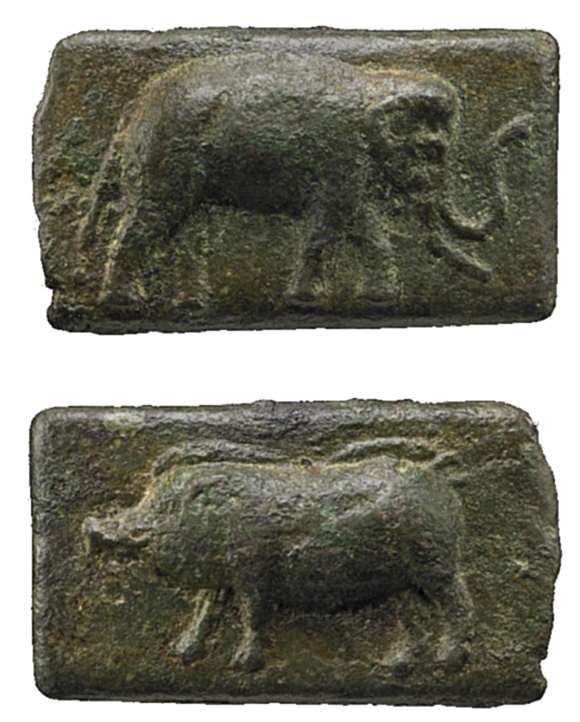 bronze (aes rude), which were of various sizes and bore no distinguishing mark. Later these became bars the length of a man's foot, the so-called asses: each weighed about a pound, and was marked off into 12 thumbs of inches. Weight became the important consideration, and the unit of value became the pound of bronze, the as libralis, which could be fashioned in tools, weapons and utensils. Because weighing these lumps was inconvenient, the practice arose of standardising the weights and certifying them with some authoritative device, which was often images of animals. Such bronze coins appear from 300 BC, and were joined by silver from 245 to 217 BC, the two metals being equally important. Silver predominated afterwards, and from the end of the Pyrrhic War took the form of the denarius, which was rated at 10 asses or 4 sestertii. In 217 BC the ass was reduced to a standard one ounce, and re-tariffed at 16 to the denarius, which itself remained the standard until the Roman Empire, when the denarius was debased and gave way to gold as the primary unit of measurement. {13}
bronze (aes rude), which were of various sizes and bore no distinguishing mark. Later these became bars the length of a man's foot, the so-called asses: each weighed about a pound, and was marked off into 12 thumbs of inches. Weight became the important consideration, and the unit of value became the pound of bronze, the as libralis, which could be fashioned in tools, weapons and utensils. Because weighing these lumps was inconvenient, the practice arose of standardising the weights and certifying them with some authoritative device, which was often images of animals. Such bronze coins appear from 300 BC, and were joined by silver from 245 to 217 BC, the two metals being equally important. Silver predominated afterwards, and from the end of the Pyrrhic War took the form of the denarius, which was rated at 10 asses or 4 sestertii. In 217 BC the ass was reduced to a standard one ounce, and re-tariffed at 16 to the denarius, which itself remained the standard until the Roman Empire, when the denarius was debased and gave way to gold as the primary unit of measurement. {13}
Social Obligations
The one feature common to proto-coinages, and applying in some half-understood fashion to money ever since, is social obligation. Money not only records what work has been done by individuals towards the communal needs of the state, but what is due to persons and institutions in terms of the honour and respect applying to their social position. China only became widely monetised in the period of Warring States, for example, and even these coin issues were often extremely local and variable, many them probably made by merchants and money-lenders, neither of whom had much social standing — i.e. the old order was being undermined. Cowries were the earlier currency, but were more used for gifts and adornment than payment for services, if such indeed existed. Chinese sources do not generally distinguish between wealth and value because these concepts did not possess the differences they now have for us. Conversely, though Chinese knife and spade coins were much sought after by surrounding tribal peoples, they were not used as money but as personal adornments by their chiefs, the foreign objects conveying status and honour. {14}
References and Further Reading
Need the 14 references and 8 illustration sources? Please consider the inexpensive ebook.
